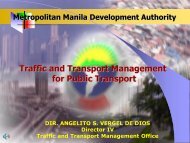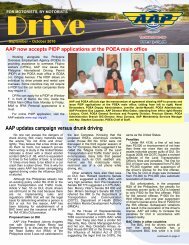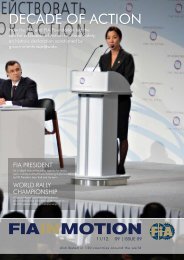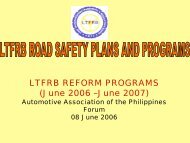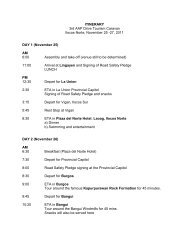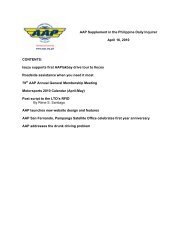ROAD INFRASTRUCTURE DEVELOPMENT IN THE PHILIPPINES
ROAD INFRASTRUCTURE DEVELOPMENT IN THE PHILIPPINES
ROAD INFRASTRUCTURE DEVELOPMENT IN THE PHILIPPINES
You also want an ePaper? Increase the reach of your titles
YUMPU automatically turns print PDFs into web optimized ePapers that Google loves.
Republic of the Philippines<br />
Department of Public Works and Highways<br />
<strong>ROAD</strong> <strong><strong>IN</strong>FRASTRUCTURE</strong><br />
<strong>DEVELOPMENT</strong> <strong>IN</strong> <strong>THE</strong><br />
PHILIPP<strong>IN</strong>ES<br />
By<br />
MARIA CATAL<strong>IN</strong>A E. CABRAL, PhD<br />
Assistant Secretary for Planning<br />
December 2009
OUTL<strong>IN</strong>E OF PRESENTATION<br />
• Strategy of Philippine Infrastructure<br />
Development Plan<br />
• DPWH Medium-Term Public Investment<br />
Program<br />
• Public Private Partnership Initiatives<br />
2
Republic of the Philippines<br />
Department of Public Works and Highways<br />
BASIC MANDATE:<br />
Planning of infrastructure, such as roads and bridges, flood<br />
control, water resources projects and other public works, and the<br />
design, construction, and maintenance of national roads and<br />
bridges, and major flood control systems.<br />
These activities are undertaken in support of the national<br />
development objectives as envisioned in the 2005-2010 Medium-<br />
Term Philippine Development Plan(MTPDP).<br />
3
Philippine Road Network<br />
Overall road<br />
network as of<br />
December 2007:<br />
201,138 km<br />
Road Density :<br />
0.671 km Per<br />
square km. of land<br />
area<br />
Overall paved<br />
road ratio: low<br />
level of 0.23 (due<br />
to huge inventory<br />
of „barangay<br />
roads‟ or farm to<br />
village roads)<br />
Road Classification<br />
North-South Backbone<br />
East-West Lateral<br />
Other Road of Strategic Importance<br />
Secondary National Road<br />
DEPARTMENT OF PUBLIC WORKS AND HIGHWAYS<br />
4
Road Densities and Paved Road Ratios in the<br />
Philippines and other ASEAN Developing Countries<br />
Countries Total Road Paved Land 2007 Paved Road Density<br />
Length Road Area Population km/sq km km/1000<br />
(km) Ratio sq km population<br />
Philippines 205,497 0.23 300,000 88,574,614 0.15 0.50<br />
Indonesia 268,030 0.48 1,919,500 234,693,997 0.07 0.55<br />
Malaysia 64,373 0.75 329,733 24,821,286 0.15 1.95<br />
Thailand 201,855 0.82 513,115 65,068,149 0.32 2.54<br />
Vietnam 153,312 0.35 330,991 85,262,356 0.16 0.63<br />
5
Philippine Road Network<br />
Total Road Lengths and Paved Road Ratio, by Classification<br />
Classification Length (km) Paved Road<br />
Ratio<br />
National Roads<br />
National Arterial<br />
National Secondary<br />
29,369<br />
15,559<br />
13,810<br />
0.70<br />
0.79<br />
0.60<br />
Provincial Roads 31,284 0.25<br />
City Roads 7,052 0.77<br />
Municipal Roads 15,803 0.34<br />
Barangay Roads 121,989 0.07<br />
TOTAL 205,497 0.23<br />
6
Philippine Road Network<br />
Condition of the Philippine Highway Network :<br />
• ONLY 80% OF TOTAL NATIONAL ARTERIAL <strong>ROAD</strong><br />
NETWORK IS PAVED, 45% OF <strong>THE</strong> PAVED<br />
SECTIONS NEED TO BE REHABILITATED, AND<br />
20% OF <strong>THE</strong> NETWORK IS STILL UNPAVED.<br />
• FOR NATIONAL SECONDARY <strong>ROAD</strong>S, ABOUT 60%<br />
IS PAVED, 39% OF <strong>THE</strong> PAVED SECTIONS NEED<br />
TO BE REHABILITATED, WHILE 44% IS STILL<br />
UNPAVED.<br />
• ABOUT 23% OF TOTAL LENGTH OF ALL <strong>ROAD</strong>S IS<br />
PAVED AND 77% IS STILL UNPAVED.<br />
7
Philippine National Road<br />
Network<br />
1. NORTH-SOUTH BACKBONE (5,233<br />
km) – main trunk line from<br />
northernmost Luzon down to<br />
Southern Mindanao interconnecting<br />
major islands.<br />
2. EAST-WEST LATERALS (2,965 km) –<br />
roads traversing backbone and<br />
across the islands (about 100 km<br />
apart)<br />
3. O<strong>THE</strong>R <strong>ROAD</strong>S (7,362 km) – direct<br />
access to important centers and<br />
areas vital for regional development<br />
and emergencies.<br />
4. NATIONAL SECONDARY <strong>ROAD</strong>S<br />
(13,810 km) – other roads which<br />
complement national arterial roads<br />
to provide access to other main<br />
population and production centers<br />
Legend<br />
Road Classification<br />
North-South Backbone<br />
East-West Lateral<br />
Other Road of Strategic Importance<br />
Secondary National Road<br />
8
<strong>IN</strong>VESTMENT REQUIREMENT<br />
(In Thousand Pesos)<br />
MEDIUM-TERM <strong><strong>IN</strong>FRASTRUCTURE</strong> <strong>IN</strong>VESTMENT PROGRAM<br />
(CY 2005-2010)<br />
Highways Flood Control Other DP WH P rojects Grand Total<br />
700,000,000<br />
650,000,000<br />
600,000,000<br />
550,000,000<br />
500,000,000<br />
450,000,000<br />
400,000,000<br />
350,000,000<br />
300,000,000<br />
250,000,000<br />
200,000,000<br />
150,000,000<br />
100,000,000<br />
50,000,000<br />
-<br />
P r i o r Y e a r s 2005 2006 2007 2008 2009 2010<br />
T o t a l ( 2 0 0 5 -<br />
2010)<br />
L a t e r Y e a r s<br />
T o t a l C o s t<br />
H i g h w a y s 5 3 , 6 1 1 , 8 2 7 2 6 , 5 0 1 , 0 3 8 3 5 , 5 0 3 , 8 2 5 3 7 , 9 9 0 , 3 8 7 5 8 , 9 9 6 , 0 5 7 8 7 , 2 3 3 , 9 6 9 1 0 2 , 6 4 1 , 7 6 1 3 4 8 , 8 6 7 , 0 3 7 3 2 8 , 5 7 7 , 2 1 7 7 3 1 , 0 5 6 , 0 8 3<br />
F l o o d C o n t r o l 1 7 , 6 7 2 , 7 3 0 4 , 9 8 7 , 2 1 3 4 , 8 3 6 , 1 2 9 7 , 3 2 9 , 2 1 9 4 , 7 0 3 , 8 2 9 7 , 6 3 9 , 4 5 1 6 , 6 9 4 , 0 6 8 3 6 , 1 8 9 , 9 0 9 6 0 , 1 7 4 , 0 7 3 1 1 4 , 0 3 6 , 7 1 2<br />
O t h e r D P W H P r o j e c t s - 7 , 2 3 1 , 7 0 3 7 , 3 8 0 , 0 0 0 1 7 , 3 4 2 , 3 9 4 2 7 , 8 5 5 , 9 7 4 2 9 , 5 2 1 , 0 8 0 3 3 , 1 4 4 , 1 6 6 1 2 2 , 4 7 5 , 3 1 7 3 6 , 3 2 0 , 1 1 5 1 5 8 , 7 9 5 , 4 3 2<br />
G r a n d T o t a l 7 1 , 2 8 4 , 5 5 7 3 8 , 7 1 9 , 9 5 4 4 7 , 7 1 9 , 9 5 4 6 2 , 6 6 2 , 0 0 0 9 1 , 5 5 5 , 8 6 0 1 2 4 , 3 9 4 , 5 0 0 1 4 2 , 4 7 9 , 9 9 5 5 0 7 , 5 3 2 , 2 6 3 4 2 5 , 0 7 1 , 4 0 5 1 , 0 0 3 , 8 8 8 , 2 2 7<br />
DEPARTMENT OF PUBLIC WORKS AND HIGHWAYS<br />
9
DESIRED OUTCOMES OVER <strong>THE</strong> MEDIUM-TERM<br />
a. National arterial roads (15,663 km) will be 95 percent<br />
paved by 2010, compared to 83 percent in 2005. This will<br />
require the paving of 2,207 km and the<br />
rehabilitation/widening/ upgrading/construction of 2,292<br />
km.<br />
a. National secondary roads (13,987 km) will be 70 percent<br />
paved by 2010, compared to the existing 52 percent in<br />
2005. This will entail the paving of 3,835 km and the<br />
rehabilitation of 1,390 km.<br />
a. National bridges (314,456) lineal meters or lm) will be 100<br />
percent permanent by 2010, compared to the 93 percent<br />
in 2005. This will involve the replacement of 12,400 lm of<br />
temporary bridges and the improvement of 6,047 lm of<br />
existing bridges. The program will also include the<br />
construction of 2,154 lm of new bridges.<br />
10
1. IMPLEMENT <strong>ROAD</strong> ACTIVITIES <strong>IN</strong> <strong>THE</strong> FOLLOW<strong>IN</strong>G ORDER OF PRIORITIES:<br />
(a) MA<strong>IN</strong>TENANCE (to preserve existing roads in good condition)<br />
(b) REHABILITATION (to restore damaged roads to original designed condition)<br />
(c) IMPROVEMENT (to upgrade road features to efficiently serve the traffic), and<br />
(d) NEW CONSTRUCTION.<br />
<strong>ROAD</strong> <strong><strong>IN</strong>FRASTRUCTURE</strong> POLICIES AND<br />
STRATEGIES<br />
2. FOCUS ON PAV<strong>IN</strong>G AND UPGRAD<strong>IN</strong>G <strong>THE</strong> NATIONAL <strong>ROAD</strong> NETWORK, ESPECIALLY<br />
<strong>THE</strong> ARTERIAL SYSTEM, BASED ON <strong>THE</strong> PAVEMENT MANAGEMENT SYSTEM US<strong>IN</strong>G<br />
<strong>THE</strong> HDM 4 MODEL.<br />
3. PRIORITIZE <strong>ROAD</strong>S SERV<strong>IN</strong>G DESIGNATED KEY AGRICULTURAL PRODUCTION<br />
AREAS, TOURISM DEST<strong>IN</strong>ATIONS, AND GROWTH CENTERS, AND THOSE WHICH<br />
WILL IMPROVE LAW AND ORDER.<br />
11
<strong>ROAD</strong> <strong><strong>IN</strong>FRASTRUCTURE</strong> POLICIES AND STRATEGIES<br />
<strong>ROAD</strong>S<br />
4. <strong>IN</strong> MAJOR URBAN CENTERS, IMPROVE TRAFFIC FLOW<br />
AT MA<strong>IN</strong> CORRIDORS, THROUGH TRAFFIC<br />
ENG<strong>IN</strong>EER<strong>IN</strong>G AND MANAGEMENT, <strong>IN</strong>TERMODAL<br />
<strong>IN</strong>TEGRATION, AND SELECTED FLYOVERS AND<br />
BYPASSES.<br />
5. ENCOURAGE MORE “Public-Private Partnership (PPP)”<br />
<strong>ROAD</strong> PROJECTS FOR HEAVILY TRAVELLED<br />
CORRIDORS WHERE COSTS CAN BE DIRECTLY<br />
RECOVERED THROUGH TOLLS.<br />
12
DPWH 2005-2010 MEDIUM TERM <strong>DEVELOPMENT</strong> PLAN<br />
<strong><strong>IN</strong>FRASTRUCTURE</strong> POLICIES AND STRATEGIES<br />
Strategies<br />
Objectives<br />
1. UNDER <strong>THE</strong> LONG AND MEDIUM TERM PLANS AND PROGRAMS:<br />
a. Pave all<br />
national roads<br />
with concrete<br />
or asphalt<br />
• Increase ratio of paved length to total length<br />
of national roads from 70% in 2004 to 95%<br />
in 2010, with International Roughness Index<br />
(IRI) of less than 4.<br />
13
DPWH 2005-2010 MEDIUM TERM <strong>DEVELOPMENT</strong> PLAN<br />
<strong><strong>IN</strong>FRASTRUCTURE</strong> POLICIES AND STRATEGIES<br />
Strategies<br />
Objectives<br />
1. UNDER <strong>THE</strong> LONG AND MEDIUM TERM PLANS AND PROGRAMS:<br />
b. Replace/construct<br />
national bridges with<br />
permanent structures<br />
throughout the country<br />
• Increase ratio of permanent to total<br />
national bridges, from 93% in 2004<br />
to 100% in 2010. 14
DPWH 2005-2010 MEDIUM TERM <strong>DEVELOPMENT</strong> PLAN<br />
<strong><strong>IN</strong>FRASTRUCTURE</strong> POLICIES AND STRATEGIES<br />
c. Prioritize roads to support the<br />
10-point agenda of the<br />
Government:<br />
10 PO<strong>IN</strong>T AGENDA BEAT <strong>THE</strong> ODDS!<br />
1. Ten Million jobs shall have been created<br />
2. Everyone of school age will be in school, in an uncrowded<br />
classroom, in surroundings conducive to learning. Three thousand<br />
school buildings a year shall have been built and a computer put in<br />
every high school.<br />
3. The budget shall have been balanced with the right revenues<br />
collected and spending on the right things ensured.<br />
4. The network of transport and digital infrastructure on<br />
which the Arroyo government embarked in 2002 shall<br />
have linked the entire country.<br />
5. Power and water shall have been regularly provided in<br />
the entire country.<br />
6. Metro Manila will have been decongested with<br />
economic activity growing and spreading to new<br />
centers of government, business and community in<br />
Luzon, in the Visayas, and in Mindanao.<br />
7. The Subic-Clark corridors will have become the most competitive<br />
international service and logistics center in the Southeast asian<br />
region<br />
8. Elections will no longer raise a doubt about their integrity. The<br />
electoral process will have been completely computerized.<br />
9. Peace will have come to Mindanao and all insurgency areas<br />
10.The divisive issues generated by EDSA 1, 2 and 3 will have had a<br />
just closure.<br />
15
DPWH 2005-2010 MEDIUM TERM <strong>DEVELOPMENT</strong> PLAN<br />
<strong><strong>IN</strong>FRASTRUCTURE</strong> POLICIES AND STRATEGIES<br />
Strategies<br />
c.1 Complete the nautical<br />
highways to transport<br />
the products of<br />
Mindanao to Luzon<br />
and Visayas<br />
Objectives<br />
• Complete paving and<br />
improve remaining<br />
unimproved road<br />
sections of the<br />
Western, Central, and<br />
Eastern Nautical<br />
Highways. Rehabilitate<br />
or replace weak bridges<br />
along the routes.<br />
16
DPWH 2005-2010 MEDIUM TERM <strong>DEVELOPMENT</strong> PLAN<br />
<strong><strong>IN</strong>FRASTRUCTURE</strong> POLICIES AND STRATEGIES<br />
Strategies<br />
c.2 Decongest<br />
Metro Manila<br />
Objectives<br />
• Complete Expressway<br />
projects and undertake<br />
projects to speed traffic<br />
in and out of Metro<br />
Manila<br />
17
DPWH 2005-2010 MEDIUM TERM <strong>DEVELOPMENT</strong> PLAN<br />
<strong><strong>IN</strong>FRASTRUCTURE</strong> POLICIES AND STRATEGIES<br />
Strategies<br />
c.3 Address<br />
critical<br />
transport<br />
bottlenecks<br />
Objectives<br />
• In urban areas, implement widening, traffic<br />
management and intersections improvement to ease<br />
congestion. In rural areas, pave and improve<br />
arterial road links between regional centers and<br />
production areas.<br />
18
DPWH 2005-2010 MEDIUM TERM <strong>DEVELOPMENT</strong> PLAN<br />
<strong><strong>IN</strong>FRASTRUCTURE</strong> POLICIES AND STRATEGIES<br />
Strategies<br />
c.4 Improve<br />
access to<br />
major tourist<br />
destinations<br />
Objectives<br />
• Pave and improve roads<br />
leading to tourist<br />
complexes at Cebu-Bohol-<br />
Camigiun, Palawan,<br />
Cordillera, Clark-Subic and<br />
Davao.<br />
19
DPWH 2005-2010 MEDIUM TERM <strong>DEVELOPMENT</strong> PLAN<br />
<strong><strong>IN</strong>FRASTRUCTURE</strong> POLICIES AND STRATEGIES<br />
Strategies<br />
c.5 Improve roads to support<br />
peace and development in<br />
Muslim Mindanao and<br />
other conflict/<br />
impoverished areas<br />
Objectives<br />
• Pave and improve<br />
roads in ARMM, Bondoc<br />
Peninsula (Quezon),<br />
Cordillera, Bicol and<br />
Samar.<br />
20
DPWH 2005-2010 MEDIUM TERM <strong>DEVELOPMENT</strong><br />
PLAN <strong><strong>IN</strong>FRASTRUCTURE</strong> POLICIES AND STRATEGIES<br />
Strategies<br />
3. Institutionalize Information<br />
Technology (IT)-aided planning<br />
processes developed under the<br />
Road Information and<br />
Management Support System<br />
(RIMSS).<br />
Objectives<br />
Implement Road Network Planning<br />
and Multi-Year Programming System<br />
(RNPMYPS), Pavement Mgt. System<br />
(PMS), Bridge Mgt. System (BMS),<br />
Routine Maintenance Mgt. System<br />
(RMMS), Road Safety Program, and<br />
Road and Bridge Information<br />
Applications (RBIA) for all national<br />
roads.<br />
21
DPWH 2005-2010 MEDIUM TERM <strong>DEVELOPMENT</strong> PLAN<br />
<strong><strong>IN</strong>FRASTRUCTURE</strong> POLICIES AND STRATEGIES<br />
Strategies<br />
Objectives<br />
4. Allocate infrastructure funds according to the following order priority:<br />
a. Preservation and<br />
maintenance (especially<br />
national roads).<br />
- to preserve existing<br />
roads in good condition<br />
• Increase allocation for maintenance of<br />
national roads from P4.8B to P13.5B<br />
by 2010 to fully meet computed needs,<br />
with International Roughness Index<br />
(IRI) of less than 4.<br />
22
DPWH 2005-2010 MEDIUM TERM <strong>DEVELOPMENT</strong> PLAN<br />
<strong><strong>IN</strong>FRASTRUCTURE</strong> POLICIES AND STRATEGIES<br />
Strategies<br />
Objectives<br />
b. Rehabilitation • To restore damaged<br />
roads to original<br />
designed condition<br />
23
DPWH 2005-2010 MEDIUM TERM <strong>DEVELOPMENT</strong> PLAN<br />
<strong><strong>IN</strong>FRASTRUCTURE</strong> POLICIES AND STRATEGIES<br />
Strategies<br />
Objectives<br />
c. Improvement • To upgrade roads<br />
features to efficiently<br />
serve the traffic (from<br />
gravel to concrete)<br />
24
DPWH 2005-2010 MEDIUM TERM <strong>DEVELOPMENT</strong> PLAN<br />
<strong><strong>IN</strong>FRASTRUCTURE</strong> POLICIES AND STRATEGIES<br />
Strategies<br />
Objectives<br />
d. New construction • Construction of bypasses,<br />
widening of roads, road<br />
opening<br />
25
FY 2009 CAPITAL OUTLAYS BUDGET<br />
(BY MODE OF F<strong>IN</strong>ANC<strong>IN</strong>G)<br />
GOP<br />
COUNTERPART<br />
P 8.027 B<br />
(31.98% of FAPs )<br />
LOCALLY -FUNDED<br />
PROJECTS<br />
P 74.674B<br />
(74.84%)<br />
FOREIGN<br />
COMPONENT<br />
P 17.072 B<br />
(68.02% of FAPs )<br />
FOREIGN-ASSISTED<br />
PROJECTS<br />
P 25.099B<br />
(25.16%)<br />
TOTAL CAPITAL OUTLAYS - P 99.773 B<br />
DEPARTMENT OF PUBLIC WORKS AND HIGHWAYS<br />
26
FY 2009 FOREIGN-ASSISTED PROJECTS<br />
BY <strong>IN</strong>TERNATIONAL FUND<strong>IN</strong>G <strong>IN</strong>STITUTION<br />
Others<br />
0.600, 2%<br />
Finnish<br />
0.255, 1%<br />
Korean<br />
0.954, 4%<br />
JICA/JBIC<br />
11.604<br />
46%<br />
Austrian<br />
1.052%, 4%<br />
Spanish<br />
0.900, 4%<br />
Saudi<br />
0.692, 3%<br />
World Bank<br />
4.382<br />
17%<br />
UK<br />
4.660, 19%<br />
TOTAL FOREIGN-ASSISTED PROJECTS – P25.099 B<br />
US Dollar = $523 Million<br />
27
PUBLIC PRIVATE PARTNERSHIP (PPP)<br />
<strong>IN</strong>ITIATIVES<br />
28
POLICY<br />
• The Government of the Philippines recognizes the<br />
indispensable role of the private sector as the main engine<br />
for national growth and development and provide the most<br />
appropriate incentives to mobilize private resources for<br />
financing the construction, operation and maintenance of<br />
infrastructure and development projects normally financed<br />
and undertaken by the Government.<br />
• Such incentives, aside from financial incentives as provided by<br />
law, include providing a climate of minimum government<br />
regulations and procedures and specific government<br />
undertakings in support of the private sector.<br />
29
PPP is essentially a contractual arrangement<br />
entered into by a national government<br />
implementing agency (IA) to authorize the<br />
private sector entity to finance, construct,<br />
operate and maintain a facility, and, in the<br />
process, to charge user fees or receive<br />
compensation from the government. The choice<br />
of the PPP mode may vary from any of the<br />
schemes authorized under the BOT Law.<br />
30
• Transfer of the burden of raising funds for projects<br />
and project risks to the private sector;<br />
• Government resources are freed and re-allocated for<br />
other urgent uses;<br />
• The entry of private sector superior technology and<br />
expertise is paved;<br />
• Project implementation is hastened and operating<br />
efficiency is assured; and<br />
• Creation of conditions for technology transfer and<br />
training.<br />
31
The fundamental legal bases for implementing<br />
PPP projects are the:<br />
BOT Law (Republic Act 6957 as amended by<br />
Republic Act 7718, approved 05 May 1994, and<br />
its Implementing Rules and Regulations (IRR);<br />
and<br />
Government Owned and Controlled Corporations<br />
(GOCC) Charter – examples are Public Estates<br />
Authority (PEA), National Development Company<br />
(NDC) and others<br />
32
CONTRACTUAL ARRANGEMENTS/SCHEMES<br />
Private sector proponents<br />
can now use different<br />
variants to implement<br />
infrastructure projects<br />
under the BOT<br />
arrangement. The BOT<br />
Law allows nine specific<br />
variants described in the<br />
table below and other<br />
modes subject to the<br />
approval of the President<br />
•Build-and-Transfer (BT)<br />
•Build- Lease-Transfer (BLT)<br />
•Build-Operate-Transfer (BOT)<br />
•Build- Own- Operate (BOO)<br />
•Build-transfer-Operate (BTO)<br />
•Contract-Add-Operate (CAO)<br />
•Develop-Operate-and-Transfer<br />
(DOT)<br />
•Rehabilitate-operate-and–<br />
Transfer (ROT)<br />
•Rehabilitate-Own-Operate (ROO)<br />
33
Under the BOT scheme, a private proponent enters into<br />
a contractual arrangement with the IA to undertake any<br />
or a combination of the BOT variants for an<br />
infrastructure facility. The following rights may be<br />
bestowed on the private proponent:<br />
To operate the facility over a fixed period, not to<br />
exceed 50 years;<br />
To charge facility users fees, tolls, rentals or share in<br />
the revenue of the project; and<br />
To recover capital, operating and maintenance<br />
expenses and earn a reasonable return on<br />
investment.<br />
34
BOT CENTER<br />
The agency mandated to coordinate and<br />
monitor projects implemented under the Act,<br />
pursuant to Administrative Order No. 67<br />
(s. 1999), as amended by Administrative<br />
Order No. 103 (s. 2000) and Executive Order<br />
No 144 (s. 2002)<br />
35
EXPRESSWAYS <strong>IN</strong> OPERATION<br />
Location Length Year Opened to<br />
Traffic<br />
Funding<br />
North Luzon Tollway<br />
Balintawak-Sta.<br />
Ines, Pampanga<br />
82.62 1977 (original) 2005<br />
(rehabilitated)<br />
BOT<br />
South Luzon Tollway<br />
Muntinlupa-<br />
Calamba, Laguna<br />
28.53 1977 (original)<br />
2008 (rehabilitated)<br />
BOT<br />
Manila-Cavite Toll<br />
Expressway<br />
Paranaque-<br />
Zapote, Cavite<br />
6.75 1999 BOT<br />
Southern Tagalog<br />
Arterial Road<br />
Batangas 41.90 2001 (Stage I)<br />
2008 (StageII)<br />
ODA<br />
BOT<br />
Metro Manila Skyway,<br />
Stage 1<br />
Metro Manila<br />
13.43 (At-grade)<br />
9.30 (viaduct)<br />
1977<br />
1997<br />
BOT<br />
Subic-Clark-Tarlac<br />
Expressway<br />
Subic-Clark-<br />
Tarlac<br />
93.77 2007 ODA<br />
276.3<br />
36
EXPRESSWAYS UNDER CONSTRUCTION/PLANN<strong>IN</strong>G<br />
Metro Manila<br />
Skyway, Stage 2<br />
Stage 3<br />
South Luzon Tollway,<br />
TR3<br />
Manila-Cavite Toll<br />
Expressway, R-1<br />
Extension<br />
North Luzon Tollway,<br />
Phase 2<br />
Segment 8.1<br />
Segment 8.2<br />
Segment 9<br />
Phase 3<br />
Segment 10<br />
Tarlac- Pangasinan-<br />
La Union (TPLEX)<br />
Bicutan-Alabang<br />
Buendia-NLEX<br />
Location<br />
Length<br />
(km)<br />
6.88<br />
17.50<br />
Started<br />
April 2009<br />
Under planning Stage<br />
Target<br />
Completion<br />
Funding<br />
2010 BOT<br />
Calamba-Sto. Tomas, Batangas 7.50 March 2008 2011 BOT<br />
Zapote- Kawit, Cavite 7.00 March 2006 2010 BOT<br />
Mindanao Ave., Quezon City-<br />
NLE, Valenzuela City<br />
C.P. Garcia-Mindanao Ave.<br />
NLEX-MacArthur<br />
MacArthur-Letre<br />
Tarlac City, Pangasinan - Rosario,<br />
La Union<br />
2.34<br />
10.23<br />
4.06<br />
5.63<br />
Total 149.72<br />
April 2009<br />
Under planning Stage<br />
-do-<br />
88.58 2008<br />
(ROWA and DE)<br />
February 2009<br />
(Construction)<br />
2010 BOT<br />
2010<br />
2013<br />
BOT<br />
37
Expressway Network in the Philippines<br />
Tarlac<br />
Manila<br />
SCTEX<br />
94km(Yen Loan)<br />
Clark<br />
(International Airport)<br />
Subic-Tipo<br />
(9km)<br />
Subic<br />
(Port)<br />
Manila Cavite Toll<br />
6km<br />
Skyway<br />
13km<br />
NLEX<br />
84km<br />
NCR (Port,<br />
International<br />
Airport)<br />
SLEX<br />
29km<br />
● Mostly BOT (ROT) Projects<br />
⇒Operated or Planned only in<br />
Central Luzon with Forecasted<br />
High Traffic Demand<br />
※SCTEX and Portion of STAR were constructed with Japanese<br />
Yen Loan<br />
● Total Length of approx. 270 km<br />
in Operation<br />
Batangus<br />
(Port)<br />
STAR<br />
39km<br />
(Yen Loan<br />
+ BOT)<br />
Operated<br />
Planned<br />
※Skyway: Two Storied Expressway of Viaduct and At-Grade<br />
38
NETWORK OF EXIST<strong>IN</strong>G AND PLANNED EXPRESSWAYS<br />
39
40<br />
CURRENT <strong>IN</strong>ITIATIVES TO DEVELOP MORE EXPRESSWAYS<br />
• Study of Master Plan of High Standard Highway Development<br />
The DPWH, with technical assistance from JICA, will formulate a Master Plan of<br />
High Standard Highways within the area of 200 km radius from Metro Manila, Metro<br />
Cebu and the Tagum, Davao-Gen. Santos corridor. A major output from this study<br />
will be identification of road network and routes for the high standard highways to<br />
meet future traffic demand. The study will be completed in April 2010 .<br />
• Cavite-Laguna (CALA) Tollway Project<br />
The project involves the following<br />
components:<br />
1. North-South Road (NS) Highway, a 27.2<br />
km. six-lane highway extending from<br />
Bacoor, Cavite in the north to Sta. Rosa-<br />
Laguna in the south.<br />
2. East-West Road, a 24.3 km. highway<br />
extending the existing Daang Hari (DH)<br />
road eastward to SLEX and westward to<br />
Tanza.<br />
With technical assistance by the World Bank,<br />
the project is being developed as a Private<br />
Public Partnership (PPP) project Target<br />
implementation of the NS Road is 2012.
CURRENT <strong>IN</strong>ITIATIVES TO DEVELOP MORE EXPRESSWAY<br />
• Feasibility Study of Central Luzon Expressway (CLEX) Project.<br />
The study will verify and confirm viability of a road directly connecting Pan-Philippine<br />
Highway (PPH) to Subic-Clark-Tarlac Expressway (SCTEX) and an extension to<br />
north-eastern Luzon. If implemented, about 30 km of expressways will serve as<br />
seamless road link in that area . The study will be completed by end of December<br />
2009.<br />
• Circumferential Road 6 (C-6)<br />
Project<br />
The C-6 Project will be a six lane<br />
tollway connecting North Luzon<br />
Expressway (NLEX) in Marilao,<br />
Bulacan and South Luzon Expressway<br />
(SLEX), in Taguig, Metro Manila. Its<br />
approximate length of 64.7 km will<br />
traverse part of Metro Manila, four (4)<br />
municipalities in Rizal Province and<br />
three (3) municipalities in Bulacan<br />
Province. A feasibility study will be<br />
conducted with technical assistance<br />
from the Korean government starting<br />
2010.<br />
41
CURRENT <strong>IN</strong>ITIATIVES TO DEVELOP MORE EXPRESSWAY<br />
• Business Case for PPP Projects<br />
The DPWH will develop a pipeline of potential expressway projects<br />
for PPP implementation within the next medium term. About six<br />
(6) expressway projects have been initially identified and this will<br />
be subjected to a business case study to determine the<br />
appropriateness of the projects for PPP. The business case will<br />
determine costs, issues, and basic clearances, especially those<br />
issues that may prevent a particular project from proceeding.<br />
Consultants to undertake the study will be procured in the first<br />
quarter of 2010.<br />
42
CONCLUSIONS<br />
• Opportunities for providing expressways have increased in recent years<br />
and are still increasing. DPWH will pursue their construction within the<br />
next medium term.<br />
43
Republic of the Philippines<br />
Department of Public Works and Highways<br />
Thank You!<br />
DPWH website: www.dpwh.gov.ph<br />
44



